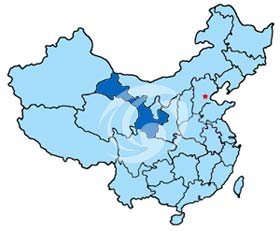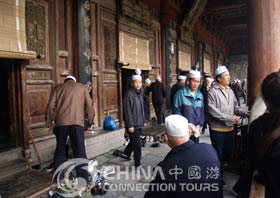 Gansu sits high atop parts of the Loess, Inner Mongolian, and Qinghai-Tibetan plateaus, and averages 1,000-3,000 meters (3,280-9,840 feet) above sea level. The Qilian Mountains on the Gansu-Qinghai border average more than 4,000 meters (13,120 ft.) above sea level. Eastern Gansu is drained by the Yellow River and its tributaries, the Weihe and Taohe, and has the potential for the development of hydropower. The Bailong River Valley, south of the Qinling mountain range, has a warm, humid climate and is a rich agricultural area. Although the greater part of the Gansu Corridor is desert and semi-desert with an arid climate, there are oases fed by run-off water from the Qilian Mountains where farming is possible. Gansu was a natural passage from the heartland of China to Xinjiang and Central Asia in ancient times.
Gansu sits high atop parts of the Loess, Inner Mongolian, and Qinghai-Tibetan plateaus, and averages 1,000-3,000 meters (3,280-9,840 feet) above sea level. The Qilian Mountains on the Gansu-Qinghai border average more than 4,000 meters (13,120 ft.) above sea level. Eastern Gansu is drained by the Yellow River and its tributaries, the Weihe and Taohe, and has the potential for the development of hydropower. The Bailong River Valley, south of the Qinling mountain range, has a warm, humid climate and is a rich agricultural area. Although the greater part of the Gansu Corridor is desert and semi-desert with an arid climate, there are oases fed by run-off water from the Qilian Mountains where farming is possible. Gansu was a natural passage from the heartland of China to Xinjiang and Central Asia in ancient times.
Gansu has an annual average temperature of 0-15ºC (32-6ºF), with a large variation between north and south. The annual average precipitation of 30-860 mm decreases from southeast to northwest.
In prehistoric times, Gansu was host to a number of Neolithic tribes. The Dadiwan culture, who left behind numerous archaeologically significant artifacts, flourished in the eastern portion of Gansu from about 6000 BC to about 3000 BC. The Majiayao and part of the Qijia cultures also lived in Gansu from 3100 BC to 2700 BC and 2400 BC to 1900 BC respectively. Qin Dynasty  tombs and artifacts have been excavated from Fangmatan near Tianshui, including a 2200 year-old map of Guixian County.
tombs and artifacts have been excavated from Fangmatan near Tianshui, including a 2200 year-old map of Guixian County.
In imperial times, Gansu was an important strategic outpost and communications link. During the Han Dynasty the Great Wall was extended across the Hexi Corridor, which runs along the “neck” of Gansu Province. The fortified towns of Jade Gate Pass (Yumenguan), near Dunhuang and Yangguan were also built to strengthen this vital corridor. Remains of the wall and the towns can still be seen.
The Mogao Caves (Caves of the Thousand Buddhas) near Dunhuang and Maijishan Caves near Tianshui contain murals of artistic and historic value. An early form of paper inscribed withChinese characters and dating to about 8 BC was discovered at the site of a Western Han garrison near the Yumen pass in August 2006.
 Han people are the largest group in Gansu. Other minority groups each with a population of more than 1,000 are the Hui, Tibetan, Dongxiang, Tu, Manchu, Yugur, Bonan, Mongolian, Salar, and Kazak.
Han people are the largest group in Gansu. Other minority groups each with a population of more than 1,000 are the Hui, Tibetan, Dongxiang, Tu, Manchu, Yugur, Bonan, Mongolian, Salar, and Kazak.
Gansu is the cradle of Chinese culture. According to archeological findings, the Yangshao culture emerged in this area about 6,000 years ago. Remnants of this ancient culture provide a rich experience for tourists. Oases, ancient towns, mountain passes, grottos, temples and part of the Great Wall attract thousands of visitors every year. The Dunhang Grottos and the Jiayuguan Pass, an important outpost in ancient China at the western end of the Great Wall, are the two top tourist attractions.

